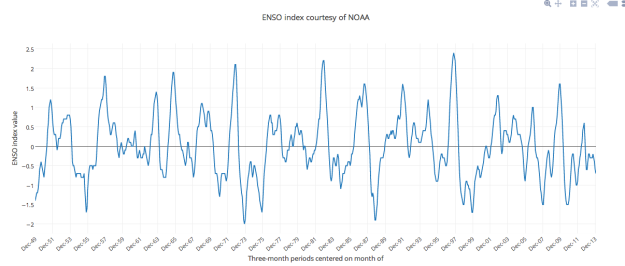 El Niño causes droughts in northern South America, killing cattle, harming water-dependent wildlife and forests, and slashing hydroelectricity output. It is often followed by La Niña. That’s not to say that floods only happen in La Niña years or droughts only happen with El Niño, but rather that the converse is true: La Niña years almost always bring floods and El Niño almost always brings drought to northern South America, and other disruptive effects elsewhere.
El Niño causes droughts in northern South America, killing cattle, harming water-dependent wildlife and forests, and slashing hydroelectricity output. It is often followed by La Niña. That’s not to say that floods only happen in La Niña years or droughts only happen with El Niño, but rather that the converse is true: La Niña years almost always bring floods and El Niño almost always brings drought to northern South America, and other disruptive effects elsewhere.
1988 La Niña Hurricanes Joan and Gilbert both affected northern South America, as did August flooding from the Magdalena river in Colombia to Ciudad Guayana, Venezuela.
1997-98 El Niño drought throughout northern Andes, cutting Peru’s growth by 2.8 percentage points and causing damages in Ecuador equal to 15 percent of GDP. Foreknowledge helped little.
1999 La Niña Caused the Vargas Tragedy, which may have killed 20,000 people in Venezuela, in December 1999.
2007-10 El Niño drought that slashed power production in Venezuela, forcing the country to import fuel oil and food, slow output from the steel and aluminum industries, and start water and power rationing that never went away. Caracas reservoirs almost dried up.
2011 La Niña Catastrophic flooding in Colombia.
El Niño may well break the lengthy drought in Chile which would be mostly a good thing for humans, cattle, sheep, lettuce, glaciers and mining projects. (Click that link if you want to learn some good Chilean Spanish.) But further north, it could start another 2- or 3-year cycle of climatic instability. I hope the region is better-prepared now than it was a few years ago for this predictable chaos.
======UPDATE April 28=====
Thomas O’Donnell writes in with the following, which is so substantive that I am just going to put it here in the post as I don’t want it to be missed.




Guri, as it happens, is in much better shape than it was in the 2010 El Niño, which followed showed up while Venezuela was still in a drought that started with the 2007 El Niño. But this is a great illustration of the kind of disruption that happens even with the kind of climate variability that is well within the historic norm.
Now think about how this bodes for climate changes that exceed historic norms.